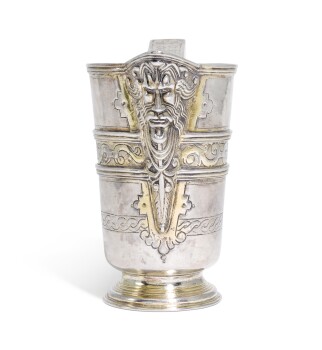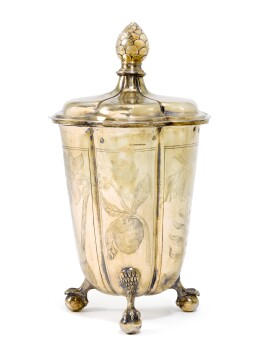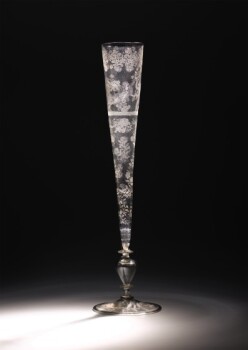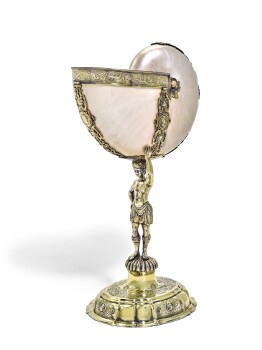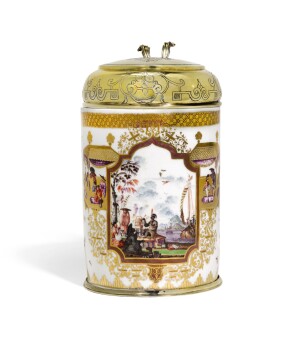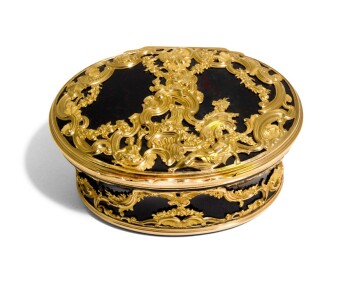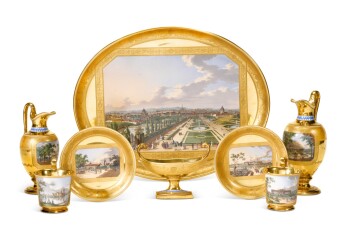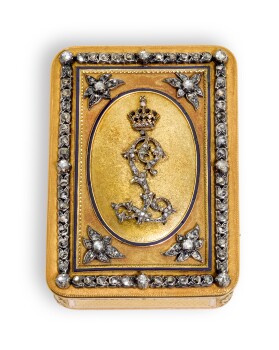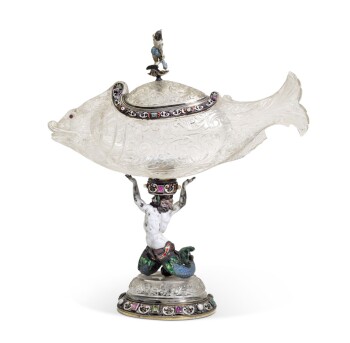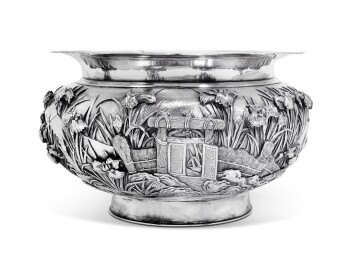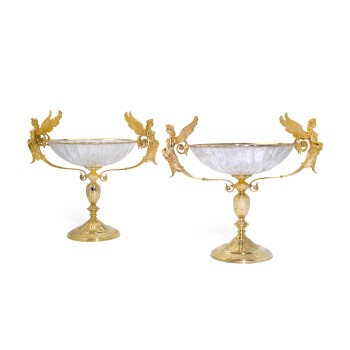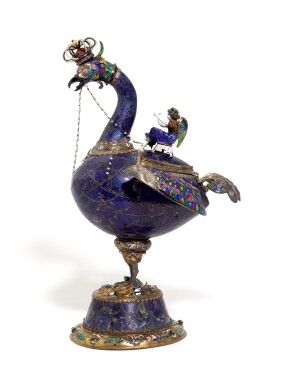T his Autumn Sotheby’s are delighted to offer a treasure trove of silver and gold boxes, porcelain, pottery and glass from across the UK and Europe from the 16th to the 20th centuries. Whether you are buying objects to use regularly such as silver flatware or a porcelain dinner service, or collecting precious objects to admire with wonder, the Style sale in London this November is filled with an exciting range of objects with estimates under £300 to £50,000.
Sale Highlights

- A Silesian engraved armorial goblet and cover, First quarter of the 18th century, Hermsdorf
Estimate £35,000 - £50,000
- A nautilus cup with German silver-gilt mounts, Paul Solanier, Augsburg, circa 1703-09
Estimate £20,000 - £30,000
- A pair of Austrian silver two-light candelabrum, Johann Georg Hann, Vienna, 1788
Estimate £6,000 - £8,000
- A Doccia blue and white dish, Circa 1745, Ginori
Estimate £4,000 - £6,000
- A parcel-gilt silver tankard, maker’s mark HK conjoined crowned, probably Brassó, late 16th century
Estimate £50,000 - £70,000
The exquisite Private European Collection (lots 1-95) described and illustrated in this sale represent the favourite objects from a collection formed many years ago. Browsing through the lots, it is not difficult to imagine how esteemed each piece was, carefully chosen and set aside for an exclusive Kunstkammer, the delight of its owner and a few of his closest friends.
It all began with a Viennese Hofjuwelier, favoured by his aristocratic customers in the Austro-Hungarian Empire in the 19th century. Inspired by the jewellery and other works which passed though his hands, he began a collection of his own. His son and granddaughter, known in both London and Vienna, continued the tradition, so much so that they became familiar with a number of their patrons' private museums, sequestered in castles and mansions which were rarely if ever open to the public. As a youth, the granddaughter's son, who had joined the business, was allowed access to these Kunstkammern, a privilege not lightly taken. Soon after the end of the Second World War he visited an uncle in London, where his enthusiasm for works of art was further fuelled by visits to museums and auction rooms.
Already by then the possessor of a choice art collection, he decided to move his best pieces to London, where he installed them in an apartment in Holland Park Gardens. He had long dreamt of forming a noteworthy group of wonderful pieces for himself, to be admired and enjoyed in the privacy of his own study. This he achieved with remarkable success.
We can easily understand the collector's fascination for his three chief passions: 16th and 17th century silver and silver-gilt from central Europe, including (lot 1) the mounted burl drinking cup, worthy of any traditional Kunstkammer of old: beautiful products of the snuff box maker's art in gold, hardstone and enamel (Lot 49); and examples of delicately-painted porcelain, many from Meissen, in whose vignettes and arabesques, flowers and gilded cartouches one could lose oneself in a reverie (Lot 67). Surrounded by these, his most precious and well-loved objects, the collector was able to find so much to admire as well as being able to look back with great pleasure on a lifetime of singular achievement.
- Circa 1600
- Circa 1640
- Circa 1680
- Circa 1703-09
- Circa 1726
- Circa 1760
- 1816
- Circa 1830
- Circa 1890
- Circa 1900
- Late 20th Century
-
 A Spanish parcel-gilt silver ewer, unmarked, circa 1600The heavy gauge of this Spanish parcel-gilt silver ewer reflects the abundance of silver available to the Spanish world from their colonial conquests in the mines of South America. The baroque mask on the spout and the strapwork decoration around the body are highlighted beautifully by the original mercury gilding.
A Spanish parcel-gilt silver ewer, unmarked, circa 1600The heavy gauge of this Spanish parcel-gilt silver ewer reflects the abundance of silver available to the Spanish world from their colonial conquests in the mines of South America. The baroque mask on the spout and the strapwork decoration around the body are highlighted beautifully by the original mercury gilding.
Estimate: 20,000 - 30,000 GBP
Lot 96 -

HyperFocal: 0 A German silver-gilt hexafoil beaker, Hans Spath, Breslau, circa 1640This German beaker, featuring claw and ball supports and pinecone finial, encloses a stippled momento mori skull on the reverse of the lid. The unusual additions of ornament of flowers with roots reflect the fascination for botany and science that occurred amongst well educated private individuals at the beginning of the modern period. This piece was made in the once-German city of Breslau, one of the few Silesian cities to stay Protestant after the Thirty Years War.
Estimate: 10,000 - 15,000 GBP
Lot 13 -
 A façon-de-venise diamond-point-engraved flute, Circa 1680, Low CountriesFine-line engraving on glass was an early free-hand technique used by the Romans and in the Islamic world. It was revived by the Venetian mirror and glass makers in the 16th century and perfected by engravers in Holland in the 17th century.
A façon-de-venise diamond-point-engraved flute, Circa 1680, Low CountriesFine-line engraving on glass was an early free-hand technique used by the Romans and in the Islamic world. It was revived by the Venetian mirror and glass makers in the 16th century and perfected by engravers in Holland in the 17th century.
Estimate: 25,000 - 35,000 GBP
Lot 86 -
 A nautilus cup with German silver-gilt mounts, Paul Solanier, AugsburgLustrous nautilus shells set in fantastical mounts brought a touch of the Indian Ocean to the North. Wealthy Collectors were able to display their wealth and dominance by opening their kunstkammern to guests, offering them a glimpse of splendor and extravagance.
A nautilus cup with German silver-gilt mounts, Paul Solanier, AugsburgLustrous nautilus shells set in fantastical mounts brought a touch of the Indian Ocean to the North. Wealthy Collectors were able to display their wealth and dominance by opening their kunstkammern to guests, offering them a glimpse of splendor and extravagance.
Estimate: 20,000 – 30,000 GBP
Lot 25 -
 A silver-gilt mounted Meissen porcelain chinoiserie tankardThe potters of Northern Europe in the Baroque period were influenced by Chinese and Japanese porcelain. The Meissen factory produced wares which not only rivalled their Far Eastern competitors but exceeded them; to create a style of porcelain which instantly made reference to the exoticism of the East but in a way which was uniquely European.
A silver-gilt mounted Meissen porcelain chinoiserie tankardThe potters of Northern Europe in the Baroque period were influenced by Chinese and Japanese porcelain. The Meissen factory produced wares which not only rivalled their Far Eastern competitors but exceeded them; to create a style of porcelain which instantly made reference to the exoticism of the East but in a way which was uniquely European.
Estimate: 25,000-40,000 GBP
Lot 171 -
 A gold-mounted bloodstone snuff box, probably EnglishThe snuff box was a major and essential personal possession throughout European history in the 18th and 19th centuries, made in a variety of materials, from gold and silver to hardstone or tortoiseshell. The English chasing in the 18th century was particularly advanced, giving a very lively and high-relief nature on the box.
A gold-mounted bloodstone snuff box, probably EnglishThe snuff box was a major and essential personal possession throughout European history in the 18th and 19th centuries, made in a variety of materials, from gold and silver to hardstone or tortoiseshell. The English chasing in the 18th century was particularly advanced, giving a very lively and high-relief nature on the box.
Estimate: 3,000 - 4,000 GBP
Lot 47 -
 A Vienna porcelain gold-ground topographical déjeunerBy the first half of the 19th century, the great European rivals of France, Prussia, Austria and Russia sponsored porcelain manufacturers who vied with each other to produce spectacular and luxurious porcelain, frequently for the personal used of their royal patrons or as ambassadorial or political gifts
A Vienna porcelain gold-ground topographical déjeunerBy the first half of the 19th century, the great European rivals of France, Prussia, Austria and Russia sponsored porcelain manufacturers who vied with each other to produce spectacular and luxurious porcelain, frequently for the personal used of their royal patrons or as ambassadorial or political gifts
Estimate: 30,000-50,000 GBP
Lot 223 -
 A jewelled four-colour gold and enamel Royal presentation snuff box, probably HanauSnuffboxes reflected the art and craft of the goldsmith and the jeweler, but also the power and wealth of a statesman. A Royal presentation snuff boxes lid was often decorated with precious jewels in arms and crest
A jewelled four-colour gold and enamel Royal presentation snuff box, probably HanauSnuffboxes reflected the art and craft of the goldsmith and the jeweler, but also the power and wealth of a statesman. A Royal presentation snuff boxes lid was often decorated with precious jewels in arms and crest
Estimate: 20,000 - 30,000 GBP
Lot 156 -

HyperFocal: 0 A rock-crystal cup and cover with jewelled silver-gilt mounts, Hermann Ratzersdorfer, ViennaDuring the second half of the 18th century, a rediscovery of Renaissance art forms strongly influenced what people envisioned as good taste and high style. Ratzersdorfer's enamel and hardstone pieces perfectly demonstrate the revival of the Renaissance style.
Estimate: 12,000-18,000 GPB
Lot 151 -

HyperFocal: 0 An unusually large Japanese silver Iris bowl, circa 1900Made for the European market, this unusually large bowl reflects the Japanese technical skills of the early 20th century. The object is decorated with Iris, a common design element of kimonos, Japanese paintings and poetry style, Haiku, which is known for its purifying elements and was used to ward off evil energies.
Estimate: 25,000 - 35,000 GBP
Lot 136 -

HyperFocal: 0 A pair of Swiss silver-gilt mounted rock crystal tazzas, retailed by Asprey, late 20th CenturyThe 1970’s was a golden age of extravagance and no design was too fanciful not to leave the artist's drawing board to be realised in all its finest detail, in Asprey various factories. The Neoclassical style revival was demonstrated through Asprey's Middle Eastern customer’s orders.
Estimate: 24,000 - 35,000 GBP
Lot 147
Centuries of Silver
The compelling appearance combined with its role as a 'storer of value' made silver an ideal material in which to craft luxury goods. The fashion for silver tableware emerged together with the taste for fine dining and became popular among European elite.
The silver highlights of this sale comprise a very fine assortment of silver objects from the collection of a distinguished private collector. Amassed over many years, they are primarily European, dating from the 16th to the 18th century. The collector’s taste for fine ancient German silver is exemplified by the inclusion of a beautiful German silver-gilt mounted wood burl drinking cup, possibly from Augsburg, dating from mid-16th century (Lot 1) and an impressive Imperial Presentation German parcel-gilt silver cup (Lot 21) and cover which was presented to Lechmeister Georg Grossen, by the Roman Emperor at the time of the Imperial diet held in Augsburg in early 1690.
The Age of Vertu
The sale includes a very fine assortment of objects of vertu, including gold and enamel snuff boxes, fans and an impressive jewelled silver-gilt, lapis lazuli and enamel model of an ostrich (lot 150) .
Created from precious materials either to be admired simply as works of art or, more often, originally conceived for a practical purpose, objects of vertu encapsulate a vast wealth of history, imagination and artistic skill within a very small area. The snuffboxes in this sale illustrate the skills of European bijoutiers from the 18th to the 20th century, such as a charming early gold-mounted lapis lazuli snuff box, possibly Italian, circa 1735 (lot 45).
About four decades later, gold-mounted enamel boxes were at the height of fashion Paris. Also featured in this sale as part of a small group of high-quality gold boxes, is an example for which the bijoutier Charles-Alexandre Bouillerot was inspired by the naturally occurring patterns of hardstones, which he transformed into a dendritic enamel surface of plum and pale pink colour (lot 152). Meanwhile, the work of the revered and prolific Parisian goldsmith Jean-Etienne Blerzy is represented by a slightly more classical gold box with a lavish dark blue and gold ground (lot 153), and a gold box inset with a scene of a splendorous ball scene by Arthur Goossens (lot 155) demonstrates how sought-after boites-a-miniatures were in the 19th century.
Notable Porcelain
A various choice of porcelain is offered in our sale, representing the finest and most delicate work, with 18th century Meissen porcelain (lot 54-65) and Vienna porcelain (lot 69 -81) both picturing fanciful chinoiserie scenes. The sale also presents a very rare and important collection of German engraved glass, such as a Silesian engraved armorial goblet and cover, from the first quarter of the 18th century.
Porcelain highlights of our sale also comprise very nice plates and part-service from the Royal Copenhagen factory decorated with specimen sprigs of flowers or fruits (lot 228-231).









